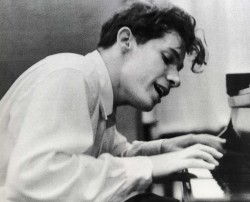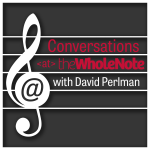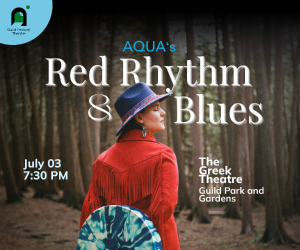How to celebrate Glenn Gould’s 80th birthday?

Hint: it’s not a straightforward homage to Gould’s quirkiness, but rather a quirky, chaotic assemblage of talented cultural voices and ideas, some more pertinent than others – both more pertinent to Gould, and ... more pertinent to any of us that might be interested in progressive, compelling music and culture.
It sorta has to be big, since he’s the biggest (Canadian musical celebrity) there ever was, and the budget, most probably, likewise. And, both because it’s big, and because Gould is so central to our ideas about musical culture and celebrity, the two-day festival at Convocation Hall needed to go beyond the narrowness of simple homage.
Gould was a solitary, cranky, over-intellectual, perhaps dysfunctionally neurotic musical performer and genius and ... what else was he, anyway? Sort of a blank page for people to write their own ideas upon, it would seem. Certainly he had critical thoughts and wrote them, spoke them at some length. And he made crucial decisions he thought were forward looking.
The Glenn Gould Prize, a Nobel Prize for music, as they styled it from the stage on Saturday, shows the way: if you can include Pierre Boulez, Murray Schafer, Yo-Yo Ma and Leonard Cohen, you’ve got a lock on diversity, of a certain sort. It’s definitely gonna be interesting when they try for a winner who isn’t male, or essentially European, culturally speaking. Oscar Peterson, representing the uniquely North-American form of jazz, goes about as far afield as any of the prize winners. And this festival certainly goes beyond all that.
All that? The throat-clearing I’ve been doing ... that’s just to say: I think it’s a good idea to celebrate Gould, and a really grand idea to do it in a super-broad way. In Toronto, the most multi-cultural city of all, you should be able to go pretty far. Let’s see how far we’ve gone, and how well we’ve done it.
Saturday (“Saturday, Saturday, Saturday, Saturday, Saturday ...”)
When I tie my bike up to a pole, and waltz up to the Convocation Hall, I’m in the bright sunshine of a late Saturday morning, round about noon, with a soccer field full of young people in full play. Lovely noises there. And some shiny tin things under the tree that must be their athletic equipment. Also the engineering students seem to have left a project there, under the portico – it sounds like a circus calliope, and looks like a Holstein cow pattern – or else there’s something different going on than a Glenn Gould conference/festival.
Well, not exactly different, but different from what I’d expected. The tin cans under the tree are Atom Egoyan’s collaboration with [someone], but you can’t find it out by searching online, nor in the paper programme, nor on Facebook. We’re heavily name-dropped and widely-advertised, but not excessively documented, on this particular map. I did hear someone say her name, the artist’s, out loud, didn’t I? Or maybe I read it someplace? Or else I’m just out of touch and you’d be better off with someone else as your spirit guide. (Only the brave should read on.)
So ... about that cow sculpture
You CAN find out about the cow sculpture, by looking through the Facebook/online/paper documentation, though nothing in the programme was as straightforward as the calm, clear conversation I had with the composer and musical sculptor Garnet Willis, who’s a friend. He told me the facts about the musical part – it’s got 37 handmade wooden “organ pipes,” mounted on and sprouting from “tree-limbs” made of inflated vinyl, with a cow pattern on them. The blower for the organ can be heard whooshing inside the sculpture, and the computer controller (which is having some cranky moments) connects by wires from inside Con Hall – and I’ve pieced together some stuff about the visual-art sculptor with whom he collaborated, Max Streicher.
This piece, including both the visual and aural parts, was certainly the most whimsical, as well as the most traditional homage to the parts of the Goldberg Variations, which are the big “pop tunes” everybody’s trying to avoid the influence of, when they make their presentations and offerings and their Gould-inspired art. The calliope sound I heard was, apparently, one of the variations in a speeded-up version, still recognizable, though a bit comical, in a good way. Sure would love to know this sculpture piece’s proper name, so I could be introduced, and so I could introduce y’all to it. Max’s online bio says it this way: “Presenting: ....the music-making sculpture at the entrance? That’s Max.”
http://www.facebook.com/GlennGouldVariations/posts/329230393830129
But what’s it like INSIDE of Con Hall? Tell us that, please.
I walked in on Paul Hoffert in the middle of his intro speech, before he played music. Basically the democratic part of the festival’s polyphony and chaos is that nobody gets more than 20 minutes. Some people didn’t know when to leave, and ... some people sorta over-explained their pieces. Hoffert, unless the beginning of his talk was clearer than the middle and the end, did a little over-explaining, and a little under-explaining. I’d maybe like to know why he quoted the music from Close Encounters in his fancy vibra-marimba piece (played over the Goldberg Aria), as the artistic-cultural connection – was Gould an alien and I just haven’t realized it? – with Spielberg and Williams seems pretty far removed from any of the progressive and intellectual concerns on display elsewhere.
You’re kidding: not a Glenn Gould impersonator! Really?
This is pretty much the best decision ever, to have Rick Miller in gloves and a trenchcoat as MC, costumed up and wearing a number of Gould’s tics and vocal habits like an extra skin, walking about in between the main acts. Of course, Miller is not just a Glenn Gould impersonator, he’s a fountain of other wild pop-cultural references. The best thing on Saturday was how he discussed who Gould was, using the voices of about a dozen characters from The Simpsons. Or maybe it was when he posed for a cover shot of the Variations, showing off about 32 vignettes in a minute. Or ... wait, maybe it was that crazy bit where Leonard Cohen interviewed Glenn Gould. Kinda like Rick Miller doing Glenn Gould doing Leonard. You hadda be there, and I count myself lucky that I was. Rick kept things light and forward moving, almost rescuing everyone who had to be rescued from herself, and hardly going off the rails into the Ditch of Disrespect at all.
For instance, how many times can you say needs no introduction (without using that horrid catchword “seminal,” especially)
Here’s where Rick did really good duty, in his way of getting us ready to receive Robert Wilson, and Norman Jewison. Each of them had something to say, Jewison, after a really long montage of justifying film clips, and Wilson after a provocative bit of misdirection in Big White Letters on a Big Black Screen: Media + Technology = ART
You wouldn’t want to say bad things about such elders. Jewison offered a folksy memoir, both of his first encounter with Gould – they were boys, when Glenn played “God Save the King” in an astonishing way – and about his foundations as a justice-seeking filmmaker. (Jewison had at least one big light-bulb moment as a demobilized Navy vet, right after the war, when a bus driver in the American South ordered him to the front of an accidentally-de-segregated bus.)
But Robert Wilson was breathtaking. If I’d known he was gonna begin with a stunt, I’d’ve timed how long it took him, standing there, before he said his first word. Honestly, his presence was as magnificent as that panther’s in the Rilke poem, just a total animal, with beautiful attentiveness that was almost indistinguishable from unconcern, as his eyes twitched, or blinked, and he stood there, noble and fine, fearsome and deliberate. (
http://picture-poems.com/rilke/panther.html)
He must have said a little bit of something about his piece, the one with the frog video portraits in counterpoint to the Gould recording, but it was surely incidental to this fact: he delivered, in stillness, a justification of stillness as the necessary starting component for artistic creativity. I’m not such a very still person, and most of the presenters today were pretty jittery, too, but I think I could learn a thing or two. My gratitude for Wilson’s animal presence, for his total bodily intelligence and grace, is just huge. Way beyond respect.
Other highlights: the crutch piece, the humming and the Twins (not to mention the Japanese comic)
I won’t bother to enumerate all the things that cropped up as slight annoyances, except to be privately amused by the little argument that broke out over the pronunciation of Disklavier. You say di-SCLAY-vee-er and I say dis-klɘ-veer, but God forbid that anyone should question the branding of that holy piece of technology which allows for faithful reproductions, yes, geography, time, space and the human body. Enough already. And if it’s so very good, could someone please explain to me why we needed a human body, encased in an academic career, to explain and justify it? Just leave the technology alone.
Even the giant screens I would question. Did they add value to our understanding of what we saw, or confuse us about the size of the humans who spoke and who were making culture for us? I’d rather see the Lemon Bucket Orkestra in real size, I think, though the screens were fantastic for capturing the fervent, and fertile chaos of their dancing folk-party music. Working collaboratively, but with a buzzing community intelligence, the LBO serves as a virtual antithesis to Gould’s methods, and thank God for them. (Yes, I’d sing with them, if they asked me, but no, to those who want to know – and I’m speaking of real friends in the real audience on Saturday, who actually DID ask me the question – they don’t yet use Georgian polyphony.) So giant video screens for Lemon Buckets? On balance yes, because I like the visual, especially when all the voices, both vocal and instrumental, were as well captured as they were by the live sound crew at Con Hall. I wouldn’t have chosen them for all performers, say, not for the 13-year-old piano prodigy. (And I don’t say protege, when I mean prodigy, if I may quote Ira Gershwin, one last time.)
Other Misdirections
Or, if you’re John Oswald, you’d use technology for things it was never meant to do, as for new artistic expressions. He picked apart an old technology artifact from the 80’s, called Pitch Rider, and used it to turn a Gould performance upside down, which was really interesting to listen to, and a worthy annoyance, for its resultant tonal formlessness. With Christopher Butterfield’s intelligent voice (and body, present, and looking at himself with naked curiosity on the JumboTron), Oswald showed us what Gould’s notorious humming sounded like, when it was given a foreground place, rather than taken for granted, or for a minor annoyance. That one also had the dancer, Jessica Runge, seated on a piano stool, and brilliantly filmed for the Jumbo screens, on the black mirror-like part of the player piano doing Gould’s Aria, with just a little bit of Bach, in the piano part, orchestrated rather than mapped on piano. More or less like turning Gould’s recording inside out.
The Twins, The Twins, yes! The Lombard Twins, used accordion-Bach, and danced, wearing modern street moves and “street” clothes, and they were charming. Not quite as impressive as the old-school Japanese culture comic storytelling from Katsura Sunshine; he pretty much brought down the house, with his traditional Rakugo piece about the drunk husband, but his Japanese rendering of Who’s On First was not at all bad. And even Adrienne Clarkson, as True-Blooded Canadian as she is, gave a feint towards dark humour: she regretted some of the horror of all the interviews she’s had to give (as well as the many she had to DO), she declared herself botox-free from birth (as a Chinese person with a Chinese face), and she did a plausible Clint Eastwood, by interviewing “herself” as Gould might have done it.
Marie Chouinard’s justification for her crutch piece – her ballet-with-prosthetics take, which might be called the Goldberg Variations Variations – was as well constructed as the piece was: she came on stage, set a 19-minute timer on her phone, gave a lecture with shockingly awesome video and still photos, cut to the chase, and even accepted questions, before counting herself down and out for the last 12 seconds. That was a Class Act, to show the architecture of the inflexible time limit as part of the art of respecting it, as well as respecting the audience, and the other performers and presenters. Left me wanting more. I could probably be persuaded to run away and join her arts colony, if she’s got one going.
Here, the musical credits on Chouinard’s website are what I would expect and wish for in the festival or conference, but cannot find anywhere (in Toronto):
Louis Dufort: Variations on the Variations,
Johann Sebastian Bach: Goldberg Variations,
Variations 5, 6, 8
Vocal Extracts of Glenn Gould
That even gets me to one of her main points, that our humanity is increased when we breathe with another human, especially during an artistic creation. Lotsa breath in the excerpts Chouinard showed, and the thing with the microphone in the mouth, now that was breathtaking, especially in duet – or antiphonally, rather – with the guy who had Goldberg variations a-twitching in his pelvis. Whew!
By the way ...
I would bet there were a full two minutes of untimed silence, by the way, before Robert Wilson spoke. Unprepared silence, and uncomfortable by all the rules, except his. Now that’s an idiosyncratic artist.
Odds and Ends:
I’m really sorry I was late, from a previous engagement, as I’d wanted to hear Tim Page, certainly. And I hope there was nothing unmissable at the end, as I needed to leave early, even during the performance of someone who outstayed his welcome. Clever, maybe, but ... I couldn’t justify it.
Hell is bad rhymes
Certainly, I’m not in favour of more new verses to Leonard Cohen’s “Hallelujah,” necessarily, but ... I would be ready to consider them at least, were they a little lighter on the cheese, and less emphatically square, as to rhyme, “do you” with Hallelujah. God bless the Faculty of Music, and in the world to come, let them all learn vernacular singing pronunciations, right alongside the High Culture Choral Way. You say do you, but I say do ya. No other way, really, izzair?
Sunday Morning? I’ll be ... Bach.
I’ll be attending the church of the one true Gould, at Con Hall. Maybe I’ll have seen you there.
 Hint: it’s not a straightforward homage to Gould’s quirkiness, but rather a quirky, chaotic assemblage of talented cultural voices and ideas, some more pertinent than others – both more pertinent to Gould, and ... more pertinent to any of us that might be interested in progressive, compelling music and culture.
Hint: it’s not a straightforward homage to Gould’s quirkiness, but rather a quirky, chaotic assemblage of talented cultural voices and ideas, some more pertinent than others – both more pertinent to Gould, and ... more pertinent to any of us that might be interested in progressive, compelling music and culture.


